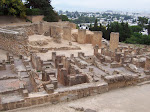We departed for Utica, another ruins site. Originally a Punic city, Utica used to lie on the coast, but the Mejerda River has since silted the site back inland. Always at odds with Carthage, Utica supported a mercenary rebellion against their rival city during the First Punic War and during the Third Punic War, Utica sided with the Romans and was rewarded when Rome took over Tunisia. Utica was also the site where, during the Roman Civil War between supporters of Pompeiius and Caesar, Cato the Younger threw himself upon his own sword having been captured by Caesar's men. A proud man, Cato preferred suicide to accepting the clemency his enemies offered. Impressed by his bravery, Uticans erected a statue in his honor by the sea.
Here are some photos of Utica, including a Punic tomb with a skeleton still inside:



After we left Utica, we stopped about a half hour later to get lunch at an outdoor "meschui" or grill. The meschui only consisted of a little stand with hanging pieces of lamb, some bread and salad meschuia, and an assortment of bottled beverages. There were also some scattered picnic tables and a playground. So while our lamb cooked, we played on the swings and the teeter totter. It was one of the best meals i've eaten here which is saying something given how good Tunisian food is. The lamb was spiced just right, and the khobs tabuna (a delicious Tunisian round bread) went perfectly with the salad meschuia. Our fingers got pretty dirty by the end of the meal but it was definitely worth it. Here's the playground:

Still on the road to Bizerte, we made another stop at Ghar el Mehl, a gorgeous white sand beach surrounded by reddish tree covered cliffs. In the cliffs sit two shrines of Islamic saints and we hiked for about an hour up the cliffs to visit one of them. Guarded by a "three headed dog," according to Mounir, which actually happened to be three dogs who lived on the roof (Mounir has quite the sense of humor), the shrine is cared for by a very old woman. The women in her family have been taking care of the shrine for decades. The woman could not have been more than four and a half feet tall, and she invited us in while she sat barefoot and cooked mint tea for us. She explains that people will often visit the shrine and bring decorations for it and that sometimes visitors even stay the night. After the hour long uphill trek to the shrine, I wondered exactly how dedicated these visitors must be. Here are some pictures of the shrine and the beach:




Mounir agreed that after we finish up our independent study projects that we should come back to the beach when it's warm enough to swim. I can't wait---it's the prettiest beach I've seen here. When we reached Bizerte that night, it was already dark. We walked around the medina and along the canal and explored the fort that looms over the city. Bizerte is an interesting place, the most European of any of the cities in Tunisia, and a strategic Mediterranean port. After Tunisian independence in 1956, the French continued to hold Bizerte, afraid of losing foothold in the southern Mediterranean. The Tunisian army and navy blockaded the city in 1961, sparking a 3 day battle that left 700 Tunisians and 24 French dead. France finally let go of the city under international pressure in October of 1963.
I wish we had had more time to explore Bizerte, we only had a few hours that night. That was enough time, however, to discover the wonder that is the lablabi sandwich. You might all remember lablabi from the recipe entry I posted a few months ago. It's a chickpea soup with spices and mashed up pieces of bread---looks disgusting, tastes delicious. Well Bizerte is apparently the only place where you can find lablabi in sandwich form, inside out, if you will: bread on the outside filled with the chickpea slop, harissa, cumin, and some olives. It's SO good. Knowing we had dinner back at the hotel in an hour, Emily and Ryan and I still couldn't resist splitting one between the three of us. It was an experience we absolutely could not miss out on. Unfortunately I don't have any pictures of Bizerte...my camera got a lot of sand in it at Ghar el Mehl and didn't stop acting up until I got to Tabarka the next day.
We returned to the hotel that night, trying to get some sleep in before our departure to Tabarka the next day.

I really liked all the history you packed into this post, it was a very enjoyable read :)
ReplyDeleteAlso, again... why am I not surprised that you brought up food? Haha, sounds delicious though, I love lamb meat.
You should take better care of your camera, I love all the pictures you have taken so far. It would have been really nice to see Bizerte from your eyes :)